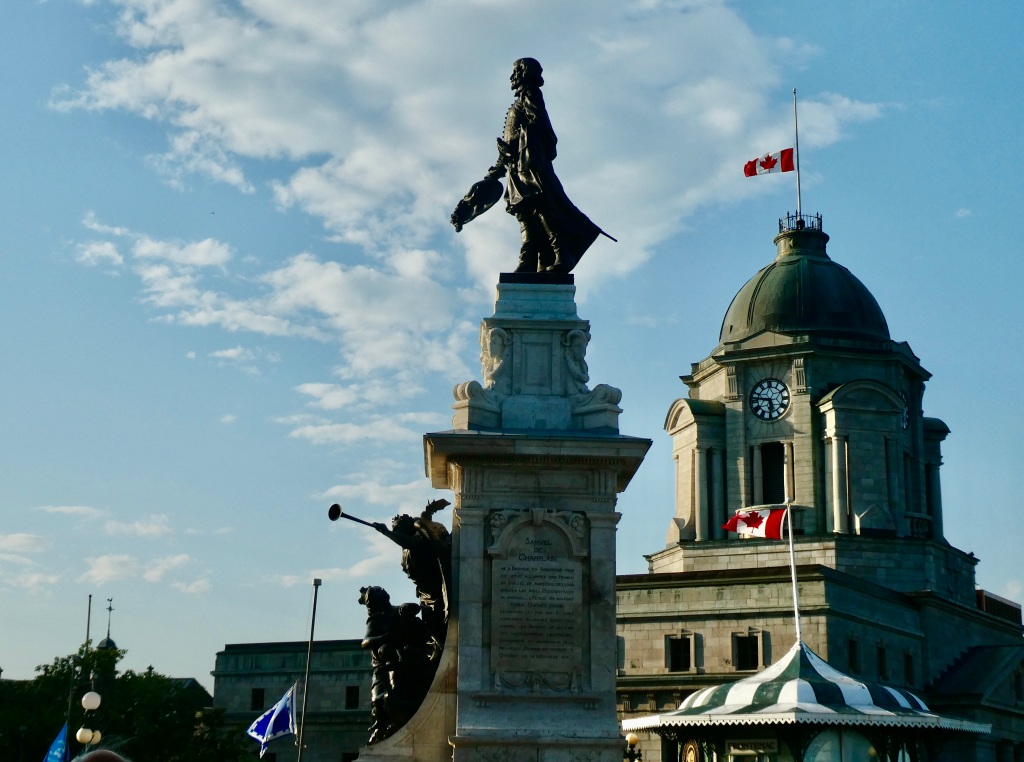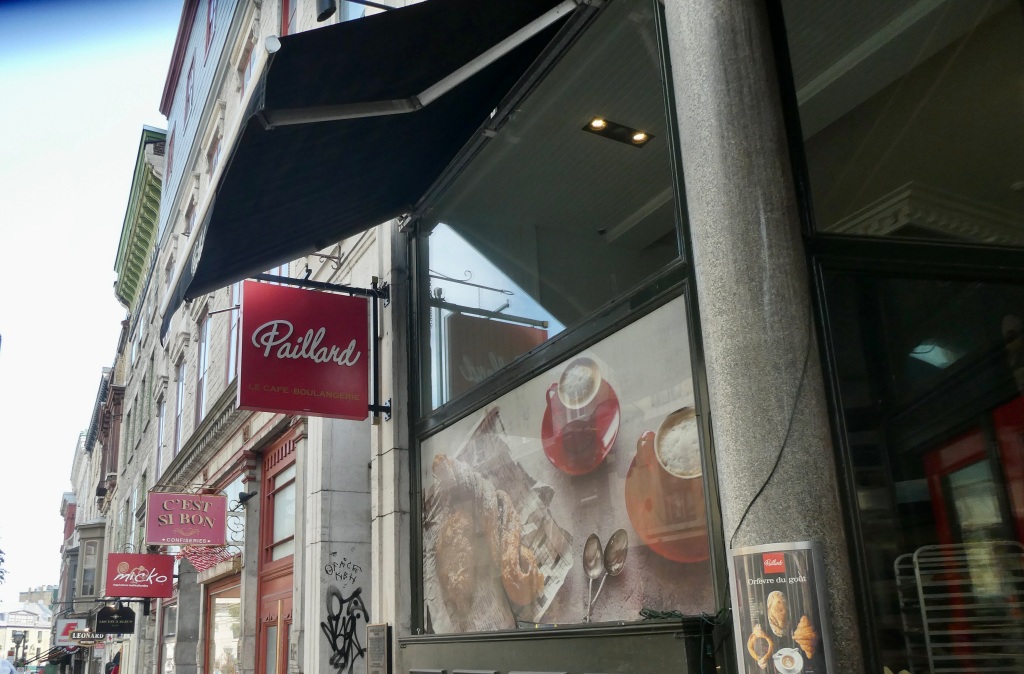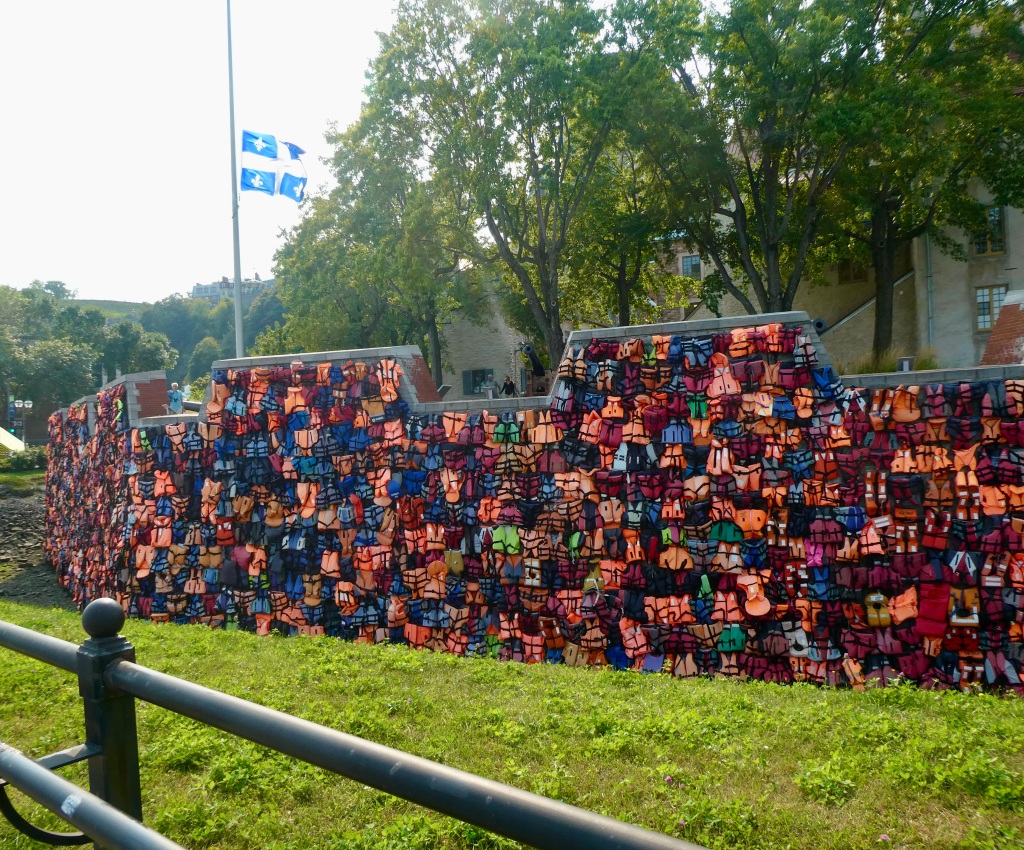As Randy languished in quarantine, the rest of us went on with being tourists. Poor Randy.

One of our first stops was the beautiful Parliament Building. Barely visible are statues, along the ground floor and in the alcoves, of famous people in Quebec government history.
There is a museum just below street level within the Parliament Building.

We learned that Canadian women gained the right to vote nationally during the First World War. Quebec women protested in February 1922 for the right to vote in provincial elections but those efforts were derailed by the Catholic Church. Women achieved the right to vote in Quebec provincial elections during WWII. (Women in other Canadian provinces were voting, and holding office, sooner than in Quebec.)

Our next stop was Battlefields Park, the tenth largest urban park in the world.

Included in the park are the Plains of Abraham and the Plains of Abraham Museum. This is where I was once again aware of how little I know of Canada’s history!
Inside the museum we found an amazing display of historic figures made of paper!

“La Corriveau” is thought of as a wicked witch in Quebec. Marie-Joseph Corriveau was a farmer and mother. In 1763, when she was only 27 years old, she was accused of murdering her husband. She was convicted and hanged on the Plains of Abraham.

Louis Joseph de Montcalm and lames Wolfe were generals who battled on the Plains of Abraham as part of the Seven Year War between France and England.

The First Nation peoples initially helped France against British invaders.

On September 13, 1759 in the Battle on the Plains of Abraham, General Wolfe led the British in a surprise attack and defeated the French. Both Wolfe and the French commander, the Marquis de Montcalm, died of their wounds. The battle was over within 30 minutes but was long-lasting in result. The battle allowed the British to take control of Quebec City leading them to take control of Canada the following year.
In order to insure that French Canadians stayed neutral during the American revolution, the British allowed them to keep their language and remain Catholic.
Under British rule, the Quebec Citadel’s military routines were British but the language was French.
In 1943, Canadian Prime Minister Mackenzie King, Theodore Roosevelt and Winston Churchill all stayed within the Citadel while in Quebec City to plan the Normandy Invasion in 1943. (Author Ian Fleming was part of Churchill’s secret service.)

The leaders, and their wives, came back in 1944 and enjoyed dinner at the Chateau Frontenac Hotel.

We were in Quebec City when Queen Elizabeth II passed away. It was touching to see the many ways she was honored.

Our next activity was to tour the Chateau Frontenac. Frontenac was a former Quebec governor. The hotel was built in 1893 by Canada Pacific Railway as a way to promote tourism.

The hotel was expanded in 1909 and again in 1919. It is always visible in the skyline of the historic section of the Quebec City.

There are 600 rooms now, many far more elaborate than the one we were shown!

Between the hotel and the waterfront is the Dufferin Terrace.

Near the entrance to the Château Frontenac Hotel is a monument to Samuel de Champlain, the founder of Québec City, and the first European to explore the Great Lakes.

There were always singers, dancers, artists and, in this case, acrobats performing in front of the main entrance to the Chateau Frontenac.

There was a street fair atmosphere.

Our next activity was a Quebec City Food Tour.

The first course was Yellow Pea soup, a tribute to early settlers that brought peas on their ships.

Then we had Chinese pie, an inexpensive meal fed to Chinese laborers. It has a base of mashed potatoes, with creamed corn, and usually topped with ground beef and catsup. Ours was made with roast beef and fruit catsup.

There was an interesting restroom in this restaurant – Individual stalls and bathtub to wash hands!

Our final item to eat here was a maple syrup sucker.

They poured the syrup in strips on the ice and we took turns rolling it up.

As we walked around to our tour restaurants, we saw the cyclists for the Grand Prix Cycliste De Quebec going around and around!

Our next food stop!

Croissants!

Walking to our final restaurant, we went by the Augustine Monastery. Nuns came here in 1639 to offer health care and education to all.

In the 1960s there was a quiet revolution in Quebec to reduce the influence of the church in taking care of everyone and opting for the state to have a more primary role.
The nuns renovated the building into a health hotel.

Our last food stop was for a Canadian staple… poutine!

There are territorial preferences for poutine but here we had potatoes, gravy and cheese curds. No grated cheese in Quebec – only fresh cheese curds!

Later Cindy, Darrel and I went down the funicular to Lower Town next to the St. Lawrence River. (I don’t think I even knew what a funicular was before 2022 and I had now been on several within the year.)

There was a lot of activity in Lower Town as well as shops and restaurants.

Cindy and I went in the Museum of Bad Art and sent pictures to Randy to cheer him up.

One that we sent was of this painting titled “A Mariachi In Tuanamen Square”- artist Anonymous. It was identified as an 8×10 oil on canvas, purchased in a thrift shop in Boston, 2004.

This better art is a building mural called La Fresque see Quebecois. It shows famous people and events in area history.

In a completely different kind of art, used life jackets cover the walls of Old Quebec’s Royal Battery. These life jackets were used by thousands of Syrian refugees fleeing to Europe. They are an artifact to remember those who will do whatever it takes to escape the violence of war. The artist is Ai Weiwei, a humanitarian activist.

On the other side of the battery wall are cannons. There were once cannons on both sides of the St. Lawrence River, at this narrowed section where Quebec City was built, to control access to the Great Lakes.

We saw the cyclists zipping by down below as well! After going back up the funicular, we saw the end of the race.
Next up: The end of our time in Quebec City – a little sooner than expected!

